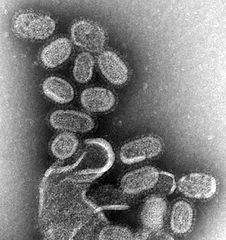In 1999, Wolfe began field work in the jungles of Cameroon to track “viral chatter,” or the regular transmission of diseases from animals to people, usually without further spread among humans. By monitoring the habits and the blood pathologies of bushmeat hunters and their kills, Wolfe and his team have identified at least three previously unknown retroviruses from the same family as HIV, as well as promoted safe practices for handling animals and animal carcasses.
“The Cameroon project demonstrated that it’s possible to collect information on viral transmission under very difficult circumstances from these highly exposed people,” Wolfe said.
With Cameroon as a prototype and a $2.5 million National Institutes of Health Pioneer Award as seed money, Wolfe has gone on to create a network of virus-discovery projects that monitor hunters, butchers, and wildlife trade and zoo workers in some of the world’s most remote viral hotspots. The network of a dozen sites in China, the Democratic Republic of Congo, Malaysia, Laos, Madagascar and Paraguay include source locations for such emerging diseases as SARS, avian flu, Nipah, Ebola and monkeypox.
There are more details of the five stages and a proposed study of the detailed origins of disease.
Wolfe and his colleagues begin by identifying five intermediate stages through which a pathogen exclusively infecting animals must travel before exclusively infecting humans. The research team identifies no inevitable progression of microbes from Stage 1 to Stage 5 and notes that many microbes remain stuck at a specific stage. The journey is arduous, and pathogens rarely climb through all five stages:
Stage 1. Agent only in animals: A microbe that is present in animals but not detected in humans under natural conditions. Examples include most malarial plasmodia.
Stage 2. Primary infection: Animal pathogens that are transmitted from animals to humans as a primary infection but not transmitted among humans. Examples include anthrax, rabies and West Nile virus.
Stage 3. Limited outbreak: Animal pathogens that undergo only a few cycles of secondary transmission among humans so that occasional human outbreaks triggered by a primary infection soon die out. Examples include the Ebola, Marburg and monkeypox viruses.
Stage 4. Long outbreak: A disease that exists in animals and has a natural cycle of infecting humans by primary transmission from the animal host but that also undergoes long sequences of secondary transmission between humans without involvement of animals. Examples include Chagas disease, yellow fever, dengue fever, influenza A, cholera, typhus and West African sleeping sickness.
Stage 5. Exclusive human agent: A pathogen exclusive to humans that involves either an ancestral pathogen present in a common ancestor of chimps and humans or involves a more recent pathogen that evolved into a specialized human pathogen. Examples include HIV, measles, mumps, rubella, smallpox and syphilis.
In addition, the team examines 25 diseases of important historic consequence to humans. Of the 25 diseases, 17 impose the heaviest world burden today: hepatitis B, influenza A, measles, pertussis, rotavirus A, syphilis, tetanus, tuberculosis, AIDS, Chagas disease, cholera, dengue hemorrhagic fever, East and West African sleeping sicknesses, falciparum and vivax malarias, and visceral leishmaniasis.
Eight more imposed heavy burdens in the past but have been reined in or eradicated thanks to modern medicine and public health practices: temperate diphtheria, mumps, plague, rubella, smallpox, typhoid, typhus and tropical yellow fever. Except for AIDS, dengue fever and cholera, most of the 25 have been important for more than two centuries.
The research team considered the varied pathologies of diseases originating in temperate (15) versus tropical (10) regions, as well as differing pathogen and geographic origins. Among the conclusions:
– Most of the temperate diseases, but none of the tropical diseases, are so-called “crowd epidemic diseases,” occurring locally as a brief epidemic and capable of persisting regionally only in large human populations. Most of the diseases originating in temperate climates convey long-lasting immunity.
– Eight of the 15 temperate diseases probably or possibly reached humans from domestic animals, three more from apes or rodents, and the other four came from still unknown sources. Thus the rise of agriculture, starting 11,000 years ago, plays multiple roles in the evolution of animal pathogens into human pathogens.
– Most tropical diseases have originated in wild, non-human primates. These animals are most closely related to humans and thus pose the weakest species barriers to pathogen transfer.
– Animal-derived human pathogens virtually all arose from pathogens of other warm-blooded vertebrates plus, in two cases, birds.
– Nearly all of the 25 major human pathogens originated in the Old Word (Africa, Europe and Asia), facilitating the conquest of the New World. Chagas disease is the only one of the 25 that clearly originated in the New World, while the debate is unresolved for syphilis and tuberculosis.
–Far more temperate diseases arose in the Old World because far more animals that furnish ancestral pathogens were domesticated there. Far fewer tropical diseases arose in the New World because the genetic distance is greater between humans and primates in this part of the globe.
The conclusions of the review illustrate large gaps in the understanding of the origins of even established major infectious diseases. Almost all studies reviewed were based on specimens collected from domestic animals, plus a few wild animal species.
The researchers propose an “origins initiative” aimed at identifying the origins of a dozen of the most important human infectious diseases as well as a global early warning system to monitor pathogens emerging from animals to humans.
 What would make this new vaccine different from the ones already available is that it would target M2e, a conserved region of influenza “A” strains. Since that part doesn’t constantly mutate and about 2/3 of seasonal epidemics and all pandemics are due to type “A” strains, it could be a very efficient weapon against repeats of the “Spanish Flu” (1918−1919) that killed at least 50 million people worldwide. Only the future will tell if phase II and III trials are successful.
What would make this new vaccine different from the ones already available is that it would target M2e, a conserved region of influenza “A” strains. Since that part doesn’t constantly mutate and about 2/3 of seasonal epidemics and all pandemics are due to type “A” strains, it could be a very efficient weapon against repeats of the “Spanish Flu” (1918−1919) that killed at least 50 million people worldwide. Only the future will tell if phase II and III trials are successful. 